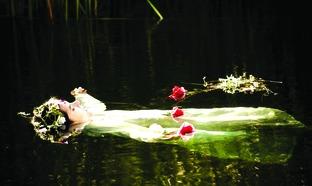A LITTLE girl who drowned in a Worcestershire pond 442 years ago may have been the inspiration behind William Shakespeare’s tragic character Ophelia.
The “tantalising” family link between the great bard and the little girl has been revealed by an academic study of accidental deaths in Tudor England.
A coroner’s report shows Jane Shaxspere drowned aged two-and-a-half while she was picking corn marigolds in Upton Warren, near Droitwich, in 1569, when the playwright would have been aged about five.
The discovery led to speculation that Jane could have been his younger cousin and that her story inspired the death of the flower-loving Ophelia character in Hamlet, who drowned after falling into a brook.
The inquest jury recorded a “misfortune” verdict on Jane’s death, which happened at a mill pond.
Project leader Steven Gunn, of Oxford University’s Faculty of History, said: “It was quite a surprise to find Jane Shaxspere’s entry in the coroner’s reports – it might just be a coincidence, but the links to Ophelia are certainly tantalising.”
Emma Smith, of Oxford’s Faculty of English Language and Literature, said: “It’s a good reminder that, while Shakespeare’s plays draw on well-attested literary sources, they also often have their roots in gossip, the mundane, and the domestic detail of everyday life (we do know this about King Lear, for example).
It’s interesting to think of Ophelia combining classical and Renaissance antecedents with the local tragedy of a drowned little girl.”
The project, which has been funded by the Economic and Social Research Council, will last for four years.
Dr Gunn said coroners’ reports of fatal accidents were a useful and hitherto under-studied way of exploring everyday life in Tudor England.
He said: “The inquiries into deaths were extensive and solemnly undertaken – the detail in which Jane Shaxspere’s death was reported suggests that children’s deaths merited careful consideration, and other young girls are similarly reported as drowning when picking flowers.”
WHAT WAS ALSO INCLUDED IN THE REPORTS
The reports show most deaths happened in summer when people were travelling around and working in the open – workmen often drowned when they stripped off to bathe in rivers and ponds after work.
Deaths from house fires were much more rare in those days because houses tended to be only one-storey high so were easier to escape from, and fewer people died from falling over.
Fatal handgun accidents overtook archery accidents in frequency in 1556.
Among the more slapstick causes of death was one man who shot himself in the head while trying to get out the arrow stuck in his longbow and another who fell into a cesspit during a toilet break.
At least three people were killed by performing bears.
One man crushed his testicles while playing a Christmas game and a Scottish man is recorded as dying after offering to demonstrate a pastime popular in his country which seems to have involved lying down and being tied up.





Comments: Our rules
We want our comments to be a lively and valuable part of our community - a place where readers can debate and engage with the most important local issues. The ability to comment on our stories is a privilege, not a right, however, and that privilege may be withdrawn if it is abused or misused.
Please report any comments that break our rules.
Read the rules hereLast Updated:
Report this comment Cancel